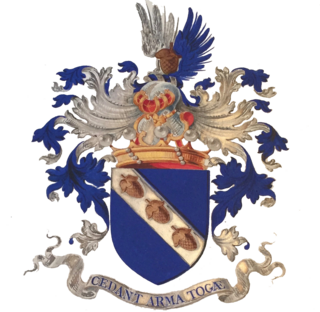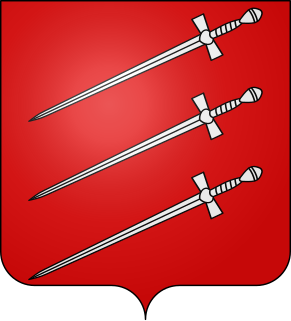Related Research Articles
The Flemish Heraldic Council advises the Flemish Government on all matters relating to heraldry. The Council was created on 11 April 1984, as the successor to the Subcommittee for Heraldry or Subcommissie Heraldiek, established in 1978. Its prime task was to supervise the granting of a coat of arms and a flag to all municipalities of the Flemish Region. Following the reorganization of the Belgian provinces, the council's field of action was extended to provincial arms and flags in 1994. Since 2000, the Council has likewise advised the Flemish Government on grants of arms to Flemish individuals and corporations. In the meantime, more than 200 of such grants have received official sanction. Grants of arms by the Flemish Government are published in the official Belgian state journal.

Burgher arms or bourgeois arms are coats of arms borne by persons of the burgher social class of Europe since the Middle Ages. By definition, however, the term is alien to British heraldry, which follows other rules.

Jean-Pierre, Baron de Bandt is a Belgian lawyer and was the President of the Coudenberg group, a Belgian federalist think tank.

The Seven Noble Houses of Brussels were the seven families or clans whose descendants formed the patrician class and urban aristocracy of Brussels.
A heraldic authority is defined as an office or institution which has been established by a reigning monarch or a government to deal with heraldry in the country concerned. It does not include private societies or enterprises which design and/or register coats of arms.

The study of Dutch heraldry focuses on the use of coats of arms and other insignia in the country of the Netherlands. Dutch heraldry is characterised by its simple and rather sober style, and in this sense, is closer to its medieval origins than the elaborate styles which developed in other heraldic traditions.
Beyens is a Belgian family of lawyers and diplomats, originating from Nazareth near Deinze and admitted into the Belgian nobility in 1851.

The Parthon de Von family is a French and Belgian family with a documented ancestry dating back to 1575 and ennobled by King Leopold I.

The d'Udekem family belongs to the nobility of Belgium since 1816.
Jonkvrouw Marie-Pierre Brigitte Olivier Corneille Verhaegen, countess Bernard d'Udekem d'Acoz, born 20 April 1966 is a Belgian historian.
Joseph Norbert Leon François Marie Ghislain "José" Anne de Molina was a Belgian magistrate, heraldist, and historian.
Events in the year 1844 in Belgium.
Events in the year 1850 in Belgium.

The Council of Heraldry and Vexillology is the Heraldic authority for the French Community of Belgium. It is the institution that advises the Government of the French Community on all matters concerning civic, personal, and familial arms and flags.

The Royal Belgian Genealogical and Heraldic Office was founded in 1942 as an asbl and has over a thousand members interested in genealogy and heraldry. It covers all regions of Belgium.
Events in the year 1849 in Belgium.

Belgian Heraldry is the form of coats of arms and other heraldic bearings and insignia used in the Kingdom of Belgium and the Belgian colonial empire but also in the historical territories that make up modern-day Belgium. Today, coats of arms in Belgium are regulated and granted by different bodies depending on the nature, status, and location of the armiger.

The Poot family is a family that was admitted to the bourgeoisie of Brussels and from 1753 was registered among the Seven Noble Houses of Brussels.
Félix Victor Goethals (1798–1872) was a Belgian genealogist and librarian.
Charles Julien Isidore de Stein d'Altenstein (1819–1896) was a civil servant in the Belgian ministry of foreign affairs, with a particular interest in heraldry and genealogy. He was born in Mesnil-Saint-Blaise (Houyet), the second son of Charles Frédéric Guillaume, baron Stein d'Altenstein and Marie-Catherine de Malmédy de Deignée. His father's family was originally from Germany. He married Justine Lysen (1827–1860), with whom he had three children, Julien, Armand and Clotilde.
References
- ↑ "Nobility". Federal Public Service Foreign Affairs. 2018-08-21. Retrieved 2020-08-05.
- ↑ Created by Royal Decree of 27 February 1996 and published in the Belgian Official Journal of 9 March 1996. It was then modified by the Royal Decree of 16 December 1999 and published in the Belgian Official Journal of 14 February 2000.
- 1 2 "Héraldique en Belgique | Association Royale Office Généalogique et Héraldique de Belgique". oghb.be. Retrieved 2020-08-05.